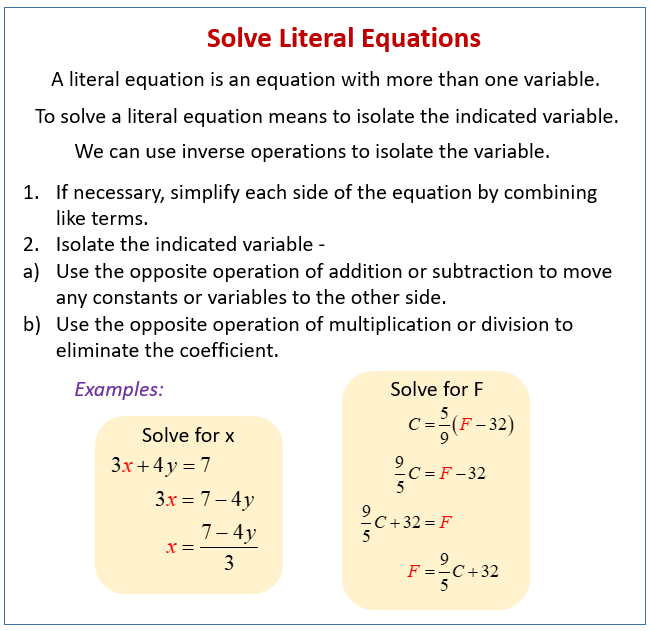Literal Equations and Formulas
A series of free Basic Algebra Lessons.
Literal equations are equations with more than one variable. Usually, we need to solve the literal equation for one of the variables. This involves moving all the other variables to the other side of the equal sign.
The following diagrams show how to find the vertex of a quadratic function and use that to convert from the general form to the vertex form. Scroll down the page for more examples and solutions for quadratic equations.

Solving Literal Equations
Sometimes we need to use methods for solving literal equations to rearrange formulas when we want to find a particular parameter or variable. Solving literal equations is often useful in real life situations, for example we can solve the formula for distance, d = rt, for r to produce an equation for rate. We will need all the methods from solving multi-step equations.
Examples:
Solve for x: 3x = 17
Solve for b: ab = 5
Solve for r: d = rt
Solve for y: x + 2y = 9
Solve for k: m/k = x
Solve for f: (f + 4)/h = 6
Solving Literal Equations
Examples on how to solve the literal equations
Examples:
Solve for x: 3x - 7y = 21
Solve for w: P = 2l + 2w
Solve for h: V = 1/3 s2 h
Solving Literal Equations
Solving for one variable in a formula.
Examples:
Solve for t: d = rt
Solve for r: I = Prt
Solve for w: 2w + 2h + l = p
Solve for r: sr + tr = u
Solve for m: mn = p - mr
Solving Literal Equations
Example 1:
Solve b for the following equations.
2b = 8
ab = c
5 + b = 9
a + b = c
2b + 1 = 13
ab + c = d
Example 2:
Solve for c.
4abc = 32
Solve for B.
A = B + C + D
Try out our new and fun Fraction Concoction Game.
Add and subtract fractions to make exciting fraction concoctions following a recipe. There are four levels of difficulty: Easy, medium, hard and insane. Practice the basics of fraction addition and subtraction or challenge yourself with the insane level.

We welcome your feedback, comments and questions about this site or page. Please submit your feedback or enquiries via our Feedback page.